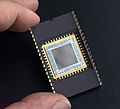Datei:Delta-Doped Charged Coupled Devices (CCD) for Ultra-Violet and Visible Detection.jpg
aus Wikipedia, der freien Enzyklopädie

Größe dieser Vorschau: 658 × 600 Pixel. Weitere Auflösungen: 263 × 240 Pixel | 527 × 480 Pixel | 843 × 768 Pixel | 1.124 × 1.024 Pixel | 2.061 × 1.878 Pixel.
Originaldatei (2.061 × 1.878 Pixel, Dateigröße: 2,46 MB, MIME-Typ: image/jpeg)
Dateiversionen
Klicke auf einen Zeitpunkt, um diese Version zu laden.
| Version vom | Vorschaubild | Maße | Benutzer | Kommentar | |
|---|---|---|---|---|---|
| aktuell | 03:41, 25. Okt. 2013 |  | 2.061 × 1.878 (2,46 MB) | wikimediacommons>Soerfm | crop |
Dateiverwendung
Die folgenden 7 Seiten verwenden diese Datei:
- CCD-Sensor
- Rückwärtige Belichtung
- Wikiup:Auskunft/Archiv/2015/Woche 03
- Wikiup Diskussion:Hauptseite/Artikel des Tages/Archiv/Vorschläge/2009
- Wikiup Diskussion:Hauptseite/Artikel des Tages/Archiv/Vorschläge/2009/Q4
- Spezial:Badtitle/NS100:Astronomie/Lesenswerte Artikel
- Spezial:Badtitle/NS100:Mikroelektronik/Galerie

